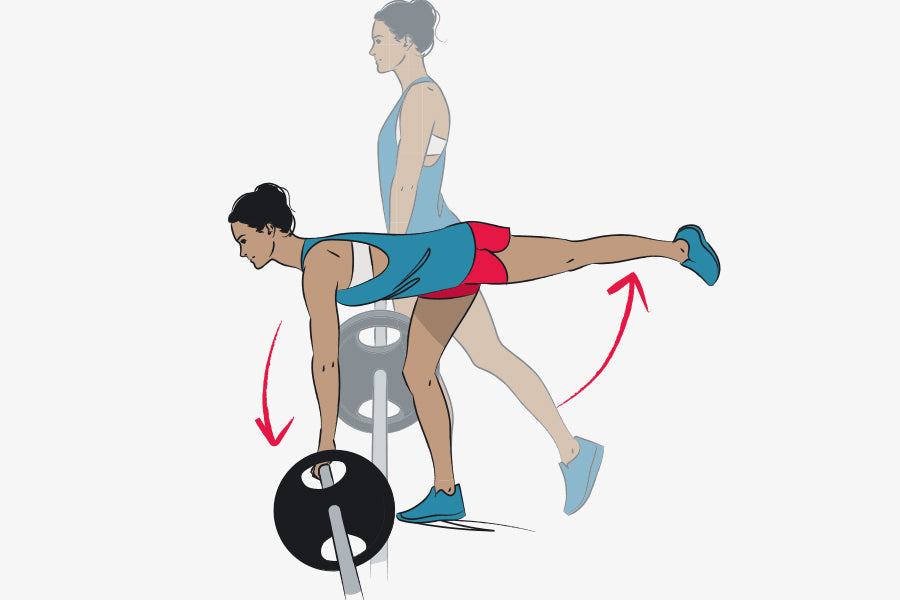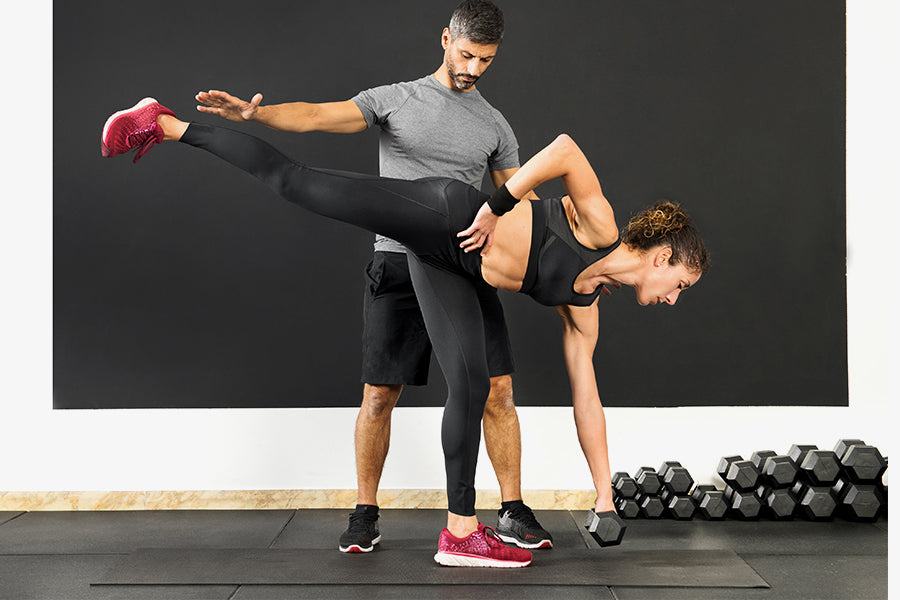Deadlifts are one of the most effective exercises that can be used for toning the whole body simultaneously. The exercise is also highly beneficial for strength building and losing weight, so mastering deadlifting skills can transform your fitness journey and take it to another level.
Now coming to single-leg deadlifts, these are an excellent way to challenge your muscles in a different way than traditional deadlifts while getting similar benefits.
Unlike the traditional version, the single-leg deadlift requires you to use one leg at a time while keeping your balance on the opposite side. This forces your core and stabilizing muscles to work harder to keep you from falling over.
Single-leg deadlifts' benefits include improved balance and coordination, increased stability in the lower body, strengthened core muscles, and better posture.
This article will explore the benefits of single-leg deadlifts and their variations. Those discovering it for the first time can pick an easy one to start with, while others who have been using it can master a new way to use it for enhanced muscle toning and overall fitness.
Related Article: 6 Proven Benefits of Performing Deadlifts Backed By Science
Basic Version of One-Leg Deadlifts

Don’t know how to do the basic single-leg deadlift? We are going to explain it here in detail. Before we begin with the correct technique, note that the conventional one-leg deadlift can be done without any weight or equipment.
Even without weight, the movement is excellent for challenging your balance and stability. Here are the steps that you can take to perform a conventional one-leg deadlift:
- Stand with your feet hip-width apart.
- Shift your weight onto one leg and lift the other foot off the ground. Keeping a neutral spine, hinge at the hips and slowly lower your torso towards the ground.
- Once your torso is parallel to the ground, pause briefly and return to standing.
- Repeat the steps to complete the desired number of sets.
That’s all. If you need extra help balancing, use a wall or chair for support as needed. To make this exercise more challenging and increase difficulty, try reaching the arms forward as you lower your torso or raise one leg higher off the ground.
Ways to Do It: Variations of the Single-Leg Deadlift
Several variations of the single-leg deadlift are available for those looking to add some variety to their workout routine. These include deadlifting with a stability ball or any other support, using a dumbbell or a kettlebell, or even an elevated single-leg deadlift.
Each variation adds its unique challenges and helps target different muscle groups further. Let’s look at some of the most exciting and popular deadlift variations you can pick based on your fitness level.
B-Stance Deadlift

One modification of the single-leg deadlift is using the support of your other foot to perform this exercise. This is best for beginners who find it challenging to deadlift independently without support. You can see the basic method we have covered above for an idea about the steps.
Once you develop the ability to do this type of deadlift, you can try doing it without the support of your other foot. Additionally, you can use a resistance band around your thighs to put mild pressure on your glutes so that your joints are acclimated to it and are prepared to level up.
Rear-Foot Elevated Single-Leg Deadlift

The rear-foot elevated single-leg deadlift is an advanced version of the traditional deadlift. It adds a vertical element to the conventional exercise that helps build balance, core strength, and stability. Here is how to perform this exercise properly:
- You’ll need to stand on one leg on a slightly elevated surface like a box or step, holding a dumbbell in one hand while the other arm is free.
- Keeping your torso straight, lean forward as far as possible, and touch the ground with the dumbbell.
- Return to an upright position, squeezing your glute muscles at the top.
- Repeat this movement for 8-10 reps before switching legs and arms.
One-Leg Deadlift With Dumbbells

The one-leg deadlift requires balance and control as you lift the weight off the floor with just one leg. The main muscle groups worked during this exercise are the glutes, hamstrings, calves, lower back, and core.
Ensure you maintain good form throughout, engaging your core and maintaining a neutral spine position. Perform 8-10 reps on each side for 1-3 sets total. If you do this consistently, this exercise is a great way to challenge your balance and develop strength in your legs. Here is how to perform this:
- You can start this exercise by standing with a dumbbell in each hand, feet slightly wider than hip-width apart.
- Next, lift your left foot off the ground, keeping it straight as you lift the dumbbells to waist height on either side of your body.
- Exhale and slowly hinge forward at the hips while keeping your chest up and back straight. As you lower the weights, keep your arms straight and your head in line with your spine.
- Lower down until your torso is parallel to the floor or as low as you can comfortably go without rounding your back. Make sure that your right leg supports all your weight.
- Inhale and press through the heel of your standing leg to extend your hips and return to standing.
- Lower the dumbbells back down to complete one rep.
Single-Leg Deadlift With Kettlebell

The single-leg deadlift with kettlebell targets the hamstrings, glutes, lower back, and core muscles. With regular practice, this exercise will help to develop solid and balanced legs and improve core stability.
This exercise can be more advanced by standing on an elevated platform to create a deficit or using a heavier kettlebell. Use caution when attempting either variation, as form can easily be compromised during this exercise. Follow these steps to perform single-leg deadlifting with a kettlebell:
- Start by standing on one leg with a slightly bent knee and the toes pointed straight.
- Hold a kettlebell in the opposite hand to the leg you are standing on.
- Keeping your back straight, slowly hinge forward from the hip, and lower the kettlebell towards the ground while maintaining a neutral spine.
- Once your upper body or the kettlebell reaches the floor, pause before reversing the motion and extending through your hip to return to the start position.
- Repeat for the desired number of reps before switching to the opposite leg. Keep your core engaged and your back flat throughout the movement, maintaining good posture from start to finish.
Single-Leg Deadlifts With a Barbell

Single-leg deadlifts with a barbell help strengthen and tone the back of your legs while also improving balance, stability, and core strength. Additionally, this is another variation of one-leg deadlifts that targets your glutes and hamstrings.
The exercise can be done with light or heavy weights, depending on the goals of your workout routine. They’re also an excellent exercise for building functional strength and mobility. You can try using heavier weights or increasing the number of repetitions to increase their intensity.
- Start by holding a barbell in both hands and standing on one leg. Slightly bend into the knee of the planted foot while keeping your back straight throughout the movement.
- Slowly lower the barbell toward the ground while maintaining balance on the planted foot and squeezing your glutes at the bottom of the movement.
- Return to the starting position by extending through your hips and engaging your glutes.
- Repeat this exercise for several repetitions before switching legs.
Benefits of Single-Leg Deadlift
The single-leg deadlift is an incredibly beneficial exercise for any fitness enthusiast. Here are a few of this move's many benefits:
Improved Balance
Single-leg deadlifts challenge your balance and stability, which can help improve your coordination and ability to stay steady on one foot. The movement makes it an excellent exercise for athletes.
Improved Core Stability
Single-leg deadlifts also work your core muscles, helping to strengthen and stabilize your torso while improving spinal stability. This exercise can also help reduce back pain and improve posture.
Improved Hip Mobility
As single-leg deadlifts require you to hinge at the hips and extend the leg behind you, they can help improve your hip joint's flexibility and mobility. This can benefit athletes engaged in sports that require a high degree of agility.
Increased Glute Activation
Single-leg deadlifts activate your hamstrings and glutes, making them an effective exercise for building strong and toned legs.
Prevents Injury
By strengthening the muscles in your legs, single-leg deadlifts can help to reduce your risk of injury when engaging in physical activities. This makes them an essential part of any fitness routine.
Improved Coordination
In addition to all the benefits mentioned above, single-leg deadlifts can help improve coordination while increasing muscular strength and endurance.
Single-leg deadlifts work on both sides of the body equally and require the perfect form to execute; that’s why it is suitable for better coordination between muscles. Moreover, improving your form can help you get the most out of this valuable exercise and prevent injury.
Single-leg deadlifts are excellent for improving balance and stability, core strength, hip mobility, and glute activation. Give them a try today to see how they can benefit your fitness journey!
Remember, it is essential to stretch before and after any workout routine, including single-leg deadlifts. Stretching can help to improve flexibility and prevent injury. So, stretch your body before and after each workout session! With the proper form and technique, single-leg deadlifts can significantly add to any fitness routine.
Related Article: 10 Deadlift Alternative Exercises for Beginners That You Can Perform At Home
FAQs
1. Traditional deadlift vs. one-leg deadlift: What are the Differences?
The traditional deadlift and one-leg deadlift are two popular exercises used for strengthening the posterior chain muscles. While they work for similar muscle groups, they have distinct differences that make them unique.
The traditional deadlift is a compound exercise that involves bending over to pick up a barbell from the floor with an overhand grip. On the other hand, the one-leg deadlift is a unilateral exercise where you stand on one leg, bend over, and hold a weight in your hands as you lift it with one arm.
Additionally, the conventional one may require more strength and stability than the one-leg deadlift since it involves picking heavier weights.
2. What are the benefits of single-leg deadlifts?
One-leg deadlift can improve the posterior chain and work on the hamstrings, lower back, glutes, core muscles, and more. It also improves balance, makes your muscles more active, and helps you with better coordination.
The Bottom Line
Single-leg deadlifts are excellent for toning your bottoms, thighs, and lower legs. Those planning to try can pick from a list of variations, including deadlifts with barbells, deadlifts with dumbbells, elevated rare-foot single-leg deadlifts with a kettlebell, and so on.








